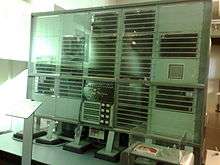Mailüfterl

Mailüfterl is a nickname for the Austrian Binär dezimaler Volltransistor-Rechenautomat (binary-decimal fully transistorized computing automaton), an early transistorized computer. The first computers of this kind in the world were TRADIC, Harwell CADET and TX-0.

Mailüfterl was built from May 1956 to May 1958 at the Vienna University of Technology by Heinz Zemanek. The first program, computation of the prime 5 073 548 261, was executed in May 1958. Completion of the software continued until 1961. The nickname was coined by Zemanek: Even if it cannot match the rapid calculation speed of American models called "Whirlwind" or "Typhoon", it will be enough for a "Wiener Mailüfterl" (Viennese May breeze).

The computer has 3,000 transistors, 5,000 diodes, 1,000 assembly platelets, 100,000 solder joints, 15,000 resistors, 5,000 capacitors and about 20,000 metres (66,000 ft) of wire. It is 4 meters (13') wide, 2.5 meters (8') high, and 50 centimeters (20") deep. The machine was comparable in calculating power to what were then considered small tube computers.
Zemanek later said about his project that it was a "semi-illegal" undertaking of an assistant professor, which he and a group of students realized without official authorization, and hence without financial support, from the university. In 1954 he traveled to Philips in the Netherlands, where he asked for a donation in kind. Transistors, invented seven years before and just beginning to be available commercially, were very difficult to obtain in quantity at any price, but Zemanek received a commitment for 1,000 rather slow hearing-aid transistors,[1] and Philips finally shipped a total of 4,000 high-quality transistors to the Austrians.
Sources
See also
External links
- Oral history interview with Heinz Zemanek, Charles Babbage Institute, University of Minnesota. Zemanek discusses his engineering education and work in radar technology during World War II. Zemanek then focuses on the development of computers in Austria: magnetic drums and magnetic memory, the MAILUFTERL computer, LOGALGOL and other compilers, the University of Vienna, where Zemanek worked on his computer, the subsequent sponsorship of the project by International Business Machines Europe, and ALGOL and PL/I language standards development.
- "Extensive site on the topic". Archived from the original on 2012-02-24.
- Technisches Museum Wien The Mailüfterl belongs to the museum's collections.
- Editorial contribution to pressetext.eu (German)
- Mailüfterl emulator in Java